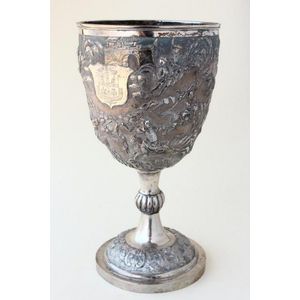Charles I Silver Goblet with Inscription, 1631
You must be a subscriber, and be logged in to view price and dealer details.
Subscribe Now to view actual auction price for this item
When you subscribe, you have the option of setting the currency in which to display prices to $Au, $US, $NZ or Stg.
- Embossed / Repousse - Embossing, also known as repousse, is the technique of decorating metal with raised designs, by pressing or beating out the design from the reverse side of the object.It is the opposite of chasing, where the decoration is applied from the front. An embossed or repoussed object may have chasing applied to finish off the design.
- Sterling Silver - Sterling silver is a mixture of 92.5% pure silver and 7.5% of another metal, usually copper. Fine silver is 99.9% pure silver, and is relatively soft and the addition of the very small amount of copper gives the metal enough strength and hardness to be worked into jewellery, decorative and household objects.
- Circa - A Latin term meaning 'about', often used in the antique trade to give an approximate date for the piece, usually considered to be five years on either side of the circa year. Thus, circa 1900 means the piece was made about 1900, probably between 1895 and 1905. The expression is sometimes abbreviated to c.1900.
- Cartouche - An ornamental panel in the form of of a shield, oval or rectangular scroll with curling edges. It may be carved into the back of a chair or the top of a sideboard, or present on a piece of silver or jewellery, and contain the initials of the original owner, heraldic symbols, or some other inscription, such as the details of a presentation.
In ceramics the term defines the central area of a vase or similar with a decorative border in one of the shapes above, into which a decorative scene or figures have been painted.
This item has been included into following indexes:
Visually similar items

A Victorian sterling silver goblet by George Unite, Birmingham 1868 with floral embossed and vacant cartouches and flute bowl 26 cm high, 515 grams

Chalice / goblet. By silversmiths Samuel Hayne and Dudley Cater Presented to Mr Andrew Torning sterling silver London 1856, circa 1857. Height 20.5 cm

An impressive mid Victorian sterling silver cup with repousse country scene depicting sheep & cottages amongst a woodland farm backdrop. Repousse most likely the work of William Edwards of Melbourne. Originally smithed in London circa 1859 by William Summe

Large Chinese late 19th/early 20th century silver goblet, by Wang Hing, with deep bowl, the exterior decorated with a continuous scene of figures fighting on horse back, set with armorial for Scots College, raised on knob stem and domed foot, impressed mak
